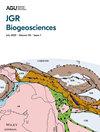Droughts Amplify Soil Moisture Losses in Burned Forests of Southeastern Amazonia
Abstract
Soil moisture is a crucial variable mediating soil-vegetation-atmosphere water exchange. As climate and land use change, the increased frequency and intensity of extreme weather events and disturbances will likely alter feedbacks between ecosystem functions and soil moisture. In this study, we evaluated how extreme drought (2015/2016) and postfire vegetation regrowth affected the seasonality of soil water content (0–8 m depth) in a transitional forest in southeastern Amazonia. The experiment included three treatment plots: an unburned Control, an area burned every three years (B3yr), and an area burned annually (B1yr) between 2004 and 2010. We hypothesized that (a) soil moisture at B1yr and B3yr would be higher than the Control in the first years postfire due to lower transpiration rates, but differences between burned plots would decrease as postfire vegetation regrew; (b) during drought years, the soil water deficit in the dry season would be significantly greater in all plots as plants responded to greater evaporative demand; and (c) postfire recovery in the burned plots would cause an increase in evapotranspiration over time, especially in the topsoil. Contrary to the first expectation, the burned plots had lower volumetric water content than the Control plot. However, we found that droughts significantly reduced soil moisture in all plots compared to non-drought years (15.6%), and this effect was amplified in the burned plots (19%). Our results indicate that, while compounding disturbances such as wildfires and extreme droughts alter forest dynamics, deep soil moisture is an essential water source for vegetation recovery.

 求助内容:
求助内容: 应助结果提醒方式:
应助结果提醒方式:


